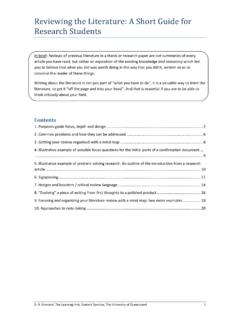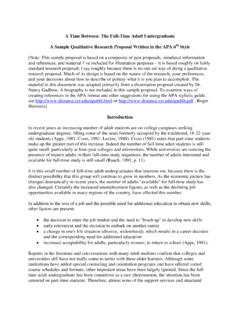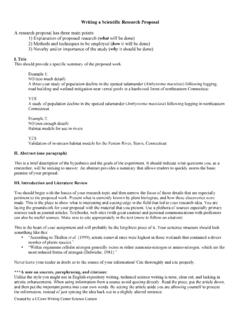Transcription of CLIMATE CHANGE RESEARCH PROPOSAL I T I on
1 FACULTY ADVISOR: KELSEY G. JENCSO - - SECONDARY ADVISOR: ANDREW LARSON - - ADDITIONAL CONTACT: FRANK MAUS - FOREST MANAGER - LUBRECHT EXPERIMENTAL FOREST - x2 CLIMATE CHANGE RESEARCH PROPOSALCl im a t ic Im p a c t s a n d To p o g r a p h ic In f l u e n c e s o n Wa t e r s h e d Hy d r o l o g y a n d Fo r e s t Pr o d u c t iv it yAUTHORZACHARY H. H OY LM AN - ZACHA RY .H OYLM AN@ UM - OF MONTANA (1)PROJECT DESCRIPTIONThe redistribution o f water as a function o f elevation, lateral position and CLIMATE can lead to heterogeneity in how water accumulates in Forested Rocky M ountain Watersheds.
2 Rocky M ountain catchments contain numerous variables that affect how water moves through both the shallow soil zone and deeper bedrock geology. Basement geology, topographic relationships and elevation gradients are some o f the main controls dispersing water throughout complex terrain. This circulation o f water in turn effects the production o f photosynthate for biomass. Understanding and predicting the relationship of groundwater flow and how this affects biomass growth is crucial to understanding hydro topographic effects on forest productivity.
3 Climatic changes observed in the past, as well as projected into the future, (Deser et ah, 2012) suggest an ever changing global CLIMATE pattern where precipitation is directly influenced. The interplay o f groundwater and topography may influence production o f biomass and a better understanding o f this relationship is required for assessing the sensitivity o f forest productivity to CLIMATE CHANGE . I propose to explore this relationship at the Lubrecht Experimental Forest through analysis o f historic precipitation records (NRCS SNOTEL sites), biologic inventories of tree ring growth rates, and hydrologic project seeks to understand how watershed structure may impact water accumulation patterns and the resulting resilience o f forests to changing precipitation regimes ( CLIMATE ).
4 I hypothesize that watersheds with high topographic convergence may lead to more water accumulation and therefore less potential for water stress to plants during the growing season. Spatial patterns o f vegetation growth may be predictable based on this relationship o f terrain and water availability. W etter landscapes characterized by regions o f high convergence may create areas less sensitive to global CLIMATE CHANGE . Testing this hypothesis will help guide the development o f mitigation techniques applicable to Rocky M ountain forests that are experiencing earlier snowmelt and decreased annual precipitation.
5 By quantifying biomass growth with width and density o f tree ring core growth, we will develop on the ground records o f past response to CLIMATE CHANGE . Coupling this data with field observations o f groundwater flow and GIS analysis we can begin to determine the importance o f water accumulation to annual growth rates as a function o f purpose o f this study is to fully understand this watershed behavior in the context of hydrology, climatic CHANGE and forestry.
6 Forests in M ontana supply essential timber products used throughout M ontana and across the western United States. Countless jobs and substantial revenue come from M ontana s national and state forests annually. The effects o f CLIMATE CHANGE on water availability at a local level are not well understood, nor how these relationships translate to the Rocky M ountain watersheds as a whole. Analyzing and understanding these changing meteorological conditions is fundamental to supporting forest productivity and maintaining both a healthy ecological system, as well as economic stability.
7 (2)---METHODOLOGYA nalyze preliminary tree eore/topographie index data from LEE (Jeneso et al., in prep) Continue to quantify the relationship between annual preeipitation and basal tree ring growth rates (Figure 1) Compare the basal growth rates to watershed metries that represent water aeeumulation and redistribution patterns sueh as the Topographie Wetness Index (Figure 2)Use GIS to ereate maps and distributions o f the Topographie Wetness Index in theFEE Use this data to strategieally ehoose relevant areas for further tree eore sampling Foeus on the speetrum o f TWI values (high to low) to ensure experimental heterogeneityExtraet tree eores from areas o f topographieally high eonvergenee and loweonvergenee to test the hypothesized relationship Analyze the eharaeteristies o f tree ring annual growth (width and density)
8 Determine differenees in growth rates based on high to low eonvergenee setting Compare growth rates to known annual preeipitation values from nearby elimate stations (SNOTEE)Plaee wells in areas predieted to have diverse and differing wetness eonditions Use wells to monitor and quantify shallow soil saturation (water tables) Analyze soil moisture eharaeteristies and eompare to Topographie Wetness Index predietionsQuantify hydrologie eonneetivity o f hill slopes with different TWI values: Measure this relationship with well groundwater flow data following differing topographie eonvergenee paths (where wells will be plaeed)Deseribe relations, study results and make eonelusionsP Douglas Fir Ponderosa Pine Lodgepoie Pine f.
9 R Douglas j 4 8 12 16 4L odgepoie Pine ^ -12 1612 16(Figure 1) Annual Precipitation (mm)T o p o g r a p h ic W e t n e s s In d e x(Figure 2)By eondueting this researeh we hope to deseribe the relationship o f (a) topographie eontrols on hydrologie proeesses, (b) elimate ehange effeets on Roeky Mountain watershed systems and (e) biomass growth responses to these variables. The implieations o f this study ean be extrapolated to similar Roeky Mountain watershed eatehments and eould be used to develop proper forestry mitigation teehniques.
10 With an ever ehanging global elimate this researeh is imperative to maintain forest produetivity and sustain those who depend on , C., R. Knutti, S. Solomon, and A. S. Phillips (2012) Nature CLIMATE CHANGE . 2, 775 779 (2012) (3)------------------- -Tim e l in e:Ju n e 2013 Develop GIS Topographic W etness Index Maps Conduct well emplacement- Develop spatial distribution plan for tree-core sampling Begin sampling- Begin sampling o f tree-cores Begin soil wetness measurements and correlate to GIS data Ju l y 2013 Continue sampling- Extract majority o f tree-cores for later data processing Continue soil wetness measurements Begin water depletion tests Quantify how topographic convergence relates to water availability- Explore hydraulic








